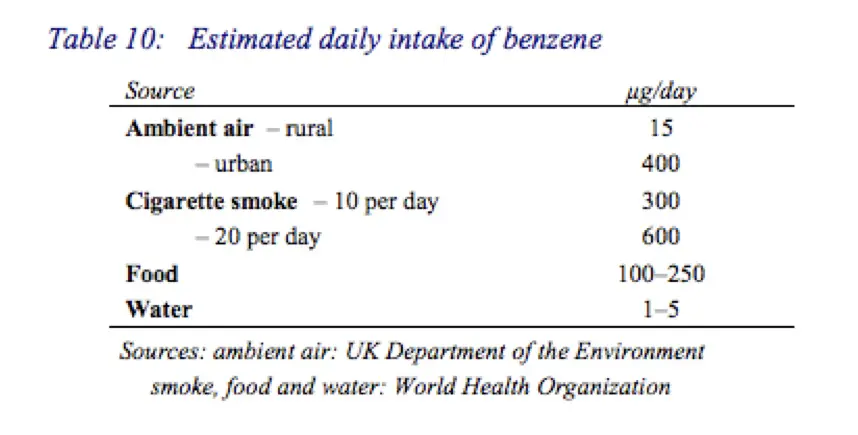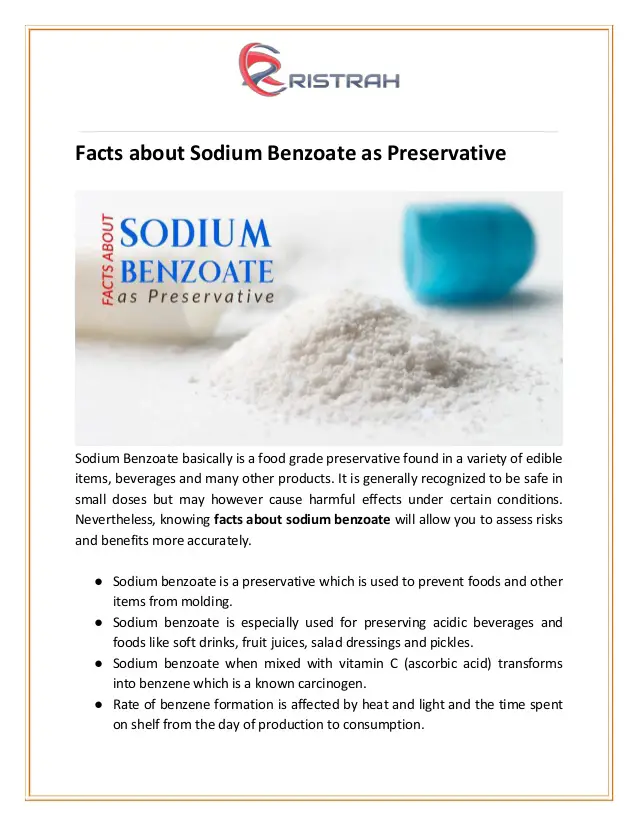Originally written by Jill Koh in 2010. Reviewed, revised and updated by Philip Button in 2020.
Sodium benzoate has sparked public health concern due to the discovery of the carcinogenic chemical benzene (Figure 1) in soft drinks (Food and Drug Administration, 2007; Food Standards Agency, 2006). Benzene is a known carcinogen “by all routes of exposure” (Ibolya et al., 2012) and is present in the atmosphere from exhaust emissions (220 μg) and cigarette smoke (7900 μg) (Figure 2). Benzene levels have only been regulated in drinking water with an upper limit of 5 ppb in the USA (Food and Drug Administration, 2007), or 10 μg/kg in UK (Food Standards Agency, 2006). An early study in 1993 reported that formation of benzene in soft drinks is attributed to the decarboxylation of benzoic acid in the presence of ascorbic acid and transition metals naturally occurring in water (Gardner & Lawrence, 1993). In addition, elevated temperatures and light can stimulate benzene formation under the conditions above which render soft drinks to be a significant source of benzene (Food and Drug Administration, 2007).
The FDA has since initiated a survey on benzene levels in soft drinks and other beverages and found 9 out of 200 beverage products with benzene levels above 5 ppb. The respective manufacturers voluntarily reformulated the products and recent testing reported benzene levels in these products were less than 1.5 ppb. On the other hand, the FDA also conducted tests on 150 drinks with 4 products containing benzene levels above the allowed 10 μg/kg limit. As such, all 4 products were recalled from the market. In its latest update the FDA has assured the public that it is working closely with the beverage industry to ensure benzene levels are minimized or eliminated where possible. One way this could be achieved, while prolonging shelf-life at the same time, is through use of the natural additives nisin and natamycin (Garavaglia et al., 2019) which reduced microbial counts and reduced the formation of benzene. The FDA has also reassured the public that sodium benzoate is still a safe preservative at a daily intake of <0.5g. This is because the body excretes benzoic acid in the urine as hippuric acid (Figure 3), leaving no accumulation of benzoic acid in the body (Belitz, Grosch, & Schieberle, 2009).
Another health concern related to sodium benzoate is the potential effect of causing hyperactivity in children. McCann et al. (2007) conducted an experiment to study the effects of artificial food colour and additives on childhood behaviour and concluded that consumption of foods with sodium benzoate or in combination with artificial colours resulted in increased hyperactivity in 3 year old and 8/9 year old children. However, the results were criticized by other professionals as inconclusive because there were observation of high sensitivity of the food additives in some hyperactive children, while others were unresponsive to the additives (Eigenmann & Haenggeli, 2007). In addition, another study reported that exposure to food additives such as sodium benzoate in children and teenagers rarely reach levels that link food additives and hyperactivity (Connolly, et al., 2010). Hence, further research is needed to establish the link between food additives and hyperactivity in adolescents due to conflicting results shown above.
Based on the evidences outlined above, further investigation needs to be carried out to ascertain the side effects of sodium benzoate on human health as results from studies remain inconclusive. However, the food industry is aware of growing consumer concerns on the usage of chemical processing aids in food products and is seeking potential alternatives. One such effort is the development of mathematical models describing growth/no growth boundaries of a highly resistant food spoilage yeast- Z. bailii to aid formulation of shelf-stable foods without inclusion of chemical preservatives (Dang, et al., 2010).
The benefits of sodium benzoate as a preservative cannot be denied and have been successfully used in various food applications. Sodium benzoate, on its own, has not been found to have any adverse effect on human health when consumed at maximum level of 4 g/day. Therefore, until concrete results on negative effects on human health have been established, concerned consumers may avoid intake of sodium benzoate by eliminating foods containing the chemical from their diet. However, considering the facts about sodium benzoate (Figure 4) and the very low chance of exposure benzene from food compared with other sources, elimination of sodium benzoate from the diet is not recommended.
References
Belitz, H. D., Grosch, W., & Schieberle, P. (2009). Food Chemistry (4th ed.). Berlin, Germany: Springer-Verlag.
Dang, T. D. T., Mertens, L., Vermeulen, A., Geeraerd, A. H., Van Impe, J. F., Debevere, J., & Devlieghere, F. (2010). Modelling the growth/no growth boundary of Zygosaccharomyces bailii in acidic conditions: a contribution to the alternative method to preserve foods without using chemical preservatives. International Journal of Food Microbiology, 137(1), 1-12.
Connolly, A., Hearty, A., Nugent, A., Mckevitt, A., Boylan, E., Flynn, A., & Gibney, M. J. (2010). Pattern of intake of food additives associated with hyperactivity in Irish children and teenagers. Food Additives and Contaminants, 27(4), 447-456.
Food and Drug Administration. (2007, 18 May 2009). Data on Benzene in Soft Drinks and Other Beverages. Retrieved 4 May 2010, from http://www.fda.gov/Food/FoodSafety/FoodContaminantsAdulteration/ChemicalContaminants/Benzene/ucm055815.htm#table2
Food Standards Agency. (2006). Benzene in soft drinks. Retrieved 4 May 2010, from http://www.food.gov.uk/science/surveillance/fsisbranch2006/fsis0606
GARAVAGLIA, Juliano, PINTO, Laura Massochin Nunes, SOUZA, Daiana de, CASTILHOS, Juliana de, ROSSI, Rochele Cassanta, MACHADO, Isabel Cristina Kasper, RAMOS, Renata Cristina de Souza, & ZIEGLER, Denise Dumoncel Righetto. (2019). Natamycin and nisin to improve shelf life and minimize benzene generation in lemon soft drinks. Food Science and Technology, 39(2), 274-279. Epub January 31, 2019.https://doi.org/10.1590/fst.13217
Gardner, L. K., & Lawrence, G. D. (1993). Benzene production from decarboxylation of benzoic acid in the presence of ascorbic acid and a transition-metal catalyst. [doi: 10.1021/jf00029a001]. Journal of Agricultural and Food Chemistry, 41(5), 693-695.
Eigenmann, P. A., & Haenggeli, C. A. (2007). Food colourings, preservatives, and hyperactivity. [doi: DOI: 10.1016/S0140-6736(07)61643-2]. The Lancet, 370(9598), 1524-1525.
Ibolya, F., Anca, P., Ajtay Mária, K., & Croitoru, M. (2012). Benzene Determination in Soft Drinks. Acta Medica Marisiensis, 58(5).
McCann, D., Barrett, A., Cooper, A., Crumpler, D., Dalen, L., Grimshaw, K., Kitchin, E., Lok, K., Porteous, L., Prince, E. and Sonuga-Barke, E. (2007). Food additives and hyperactive behaviour in 3-year-old and 8/9-year-old children in the community: a randomised, double-blinded, placebo-controlled trial. The Lancet, 370(9598), 1560-1567.





